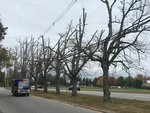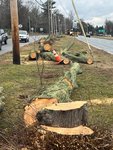Why that row of trees on Ferry Road was cut down
Several years ago a group of interested parties decided the old trees had to go and joined to devise a plan to restore the beauty of the lost lindens.
This item is available in full to subscribers.
Please log in to continue |
Register to post eventsIf you'd like to post an event to our calendar, you can create a free account by clicking here. Note that free accounts do not have access to our subscriber-only content. |
Day pass subscribers
Are you a day pass subscriber who needs to log in? Click here to continue.
Why that row of trees on Ferry Road was cut down
In 1876, when Philadelphia industrialist Herbert M. Howe bought up most of Bristol south of Griswold Avenue, including Hog Island, he did so with the intention of creating a dairy farm in the custom of the gentleman farmer who cherished the land and had the resources to build on it.
Growing up at Weetamoe (now Bristol Landing) as one of Bishop Mark Anthony DeWolf Howe’s 18 children, he knew every rock and cranny in south Bristol and came to love it dearly. Up until his death in 1916, he built upon his beloved Ferrycliffe Farm, owned by the family for some 80 years before it was sold in the 1960s to Roger Williams University.
Trained as a physician, Dr. Howe took his hobby seriously, winning acclaim for his rich Jersey cow milk, awards around New England for his famed bull Gilderoy and for his prized turkeys at Madison Square Garden. But love of Ferrycliffe didn’t stop with the fowl and livestock. His discriminating eye left its mark everywhere.
At the time there was no Mt. Hope Bridge, and the farm was the end of the line, with Ferry Road leading – as everyone knew – to the Aquidneck Island ferry. Dr. Howe understood the idyllic singularity of his farm and worked to give the approach from Bristol its own touch of grandeur.
To that effect he planted a row of welcoming linden trees along Ferry Road, beginning east of Blithewold and running south to the farm. While many of those trees, now nearly 150 years old, continue to flourish and shade the east side of Ferry Road, the southernmost dozen or so – or what was left of them – were cut down last week by Rhode Island Department of Transportation (DOT) and hauled away, leaving only stumps as reminders of their former glory.
Ravaged after years of trimming back to access electric wires, these southern lindens were also thirsting for water. Only a narrow grass traffic divider anchored the trees between two lanes of blacktop along either side. Several years ago a group of interested parties decided the old trees had to go and joined to devise a plan to restore the beauty of the lost lindens.
Those parties included the R.I. Arborist, RIDOT, National Grid (now RI Energy), the Town of Bristol and the university. Plans originally included replanting lindens in the traffic divider, but when it was noted the power lines would not accommodate tall trees, the idea was scrapped.
Roger Williams then provided an easement on its property east of the roadway, and RI Energy secured 13 young lindens (tilia Americana). They were planted by Samuel Kinder and Brother nursery, and the university has watered them through early growth. Bristol Town Administrator Steven Contente said the stumps would be ground out of the median for the town to plant smaller flowering trees such as dogwoods, crabapples or cherries this spring, with about $6,000 available for the project.
“I’m very happy all the parties came together,” Contente said, “It’s been a successful two-year campaign.”
Chris Rooney, manager of Forestry for RI Energy, echoed the sentiment, noting the cooperation of RWU and the $5,000 for the new lindens secured from a grant from the Rhode Island Tree Council. These lindens also have a life expectancy of between 100 and 150 years.
“We take our tree planting very seriously,” Contente said. “We plant more trees than we take down.” Others who played a role in this project include Community Development Director Diane Williamson, Principal Planner Ed Tanner and RWU Senior Capital Project Manager John Amitrano.
Bristol Tree Warden Steve Saracino is also pleased with the project. “This is our welcoming mat for people driving into Bristol from the Mt. Hope Bridge,” he said. “These new plantings over time will do wonders for economic development and show we care about first appearances.”
As Dr. Howe’s great-grandson, this writer believes the gentleman farmer would be sad to see some of his lindens go, but pleased to know that Bristol Point will retain its charm as new lindens and blossoming trees flourish over the years. This sentiment was nicely captured in a July 1881 article from the Massachusetts Ploughman and New England Journal of Agriculture detailing Ferrycliffe Farm:
“Were there more farmers of the high aim and enthusiastic spirit of Dr. Howe, New England would break out in smiles across its entire territory.” My faith tells me Dr. Howe sees this cooperative effort bringing then next generation of lindens to the Ferry … and also is smiling.











